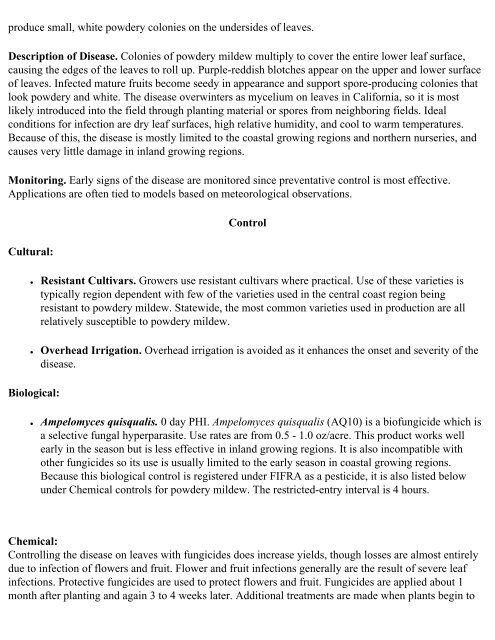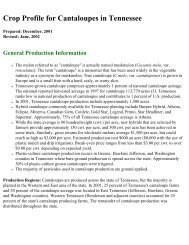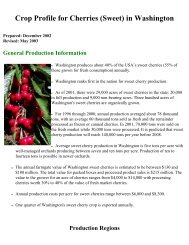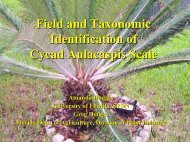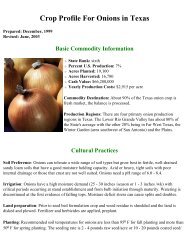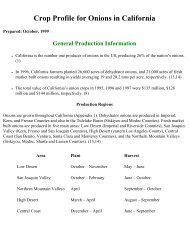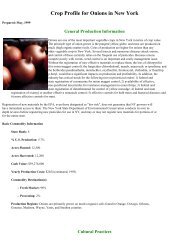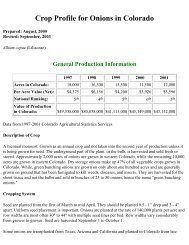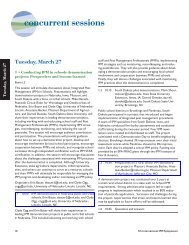Crop Profile for Strawberries in California - Regional IPM Centers
Crop Profile for Strawberries in California - Regional IPM Centers
Crop Profile for Strawberries in California - Regional IPM Centers
You also want an ePaper? Increase the reach of your titles
YUMPU automatically turns print PDFs into web optimized ePapers that Google loves.
produce small, white powdery colonies on the undersides of leaves.<br />
Description of Disease. Colonies of powdery mildew multiply to cover the entire lower leaf surface,<br />
caus<strong>in</strong>g the edges of the leaves to roll up. Purple-reddish blotches appear on the upper and lower surface<br />
of leaves. Infected mature fruits become seedy <strong>in</strong> appearance and support spore-produc<strong>in</strong>g colonies that<br />
look powdery and white. The disease overw<strong>in</strong>ters as mycelium on leaves <strong>in</strong> Cali<strong>for</strong>nia, so it is most<br />
likely <strong>in</strong>troduced <strong>in</strong>to the field through plant<strong>in</strong>g material or spores from neighbor<strong>in</strong>g fields. Ideal<br />
conditions <strong>for</strong> <strong>in</strong>fection are dry leaf surfaces, high relative humidity, and cool to warm temperatures.<br />
Because of this, the disease is mostly limited to the coastal grow<strong>in</strong>g regions and northern nurseries, and<br />
causes very little damage <strong>in</strong> <strong>in</strong>land grow<strong>in</strong>g regions.<br />
Monitor<strong>in</strong>g. Early signs of the disease are monitored s<strong>in</strong>ce preventative control is most effective.<br />
Applications are often tied to models based on meteorological observations.<br />
Cultural:<br />
Control<br />
● Resistant Cultivars. Growers use resistant cultivars where practical. Use of these varieties is<br />
typically region dependent with few of the varieties used <strong>in</strong> the central coast region be<strong>in</strong>g<br />
resistant to powdery mildew. Statewide, the most common varieties used <strong>in</strong> production are all<br />
relatively susceptible to powdery mildew.<br />
● Overhead Irrigation. Overhead irrigation is avoided as it enhances the onset and severity of the<br />
disease.<br />
Biological:<br />
● Ampelomyces quisqualis. 0 day PHI. Ampelomyces quisqualis (AQ10) is a biofungicide which is<br />
a selective fungal hyperparasite. Use rates are from 0.5 - 1.0 oz/acre. This product works well<br />
early <strong>in</strong> the season but is less effective <strong>in</strong> <strong>in</strong>land grow<strong>in</strong>g regions. It is also <strong>in</strong>compatible with<br />
other fungicides so its use is usually limited to the early season <strong>in</strong> coastal grow<strong>in</strong>g regions.<br />
Because this biological control is registered under FIFRA as a pesticide, it is also listed below<br />
under Chemical controls <strong>for</strong> powdery mildew. The restricted-entry <strong>in</strong>terval is 4 hours.<br />
Chemical:<br />
Controll<strong>in</strong>g the disease on leaves with fungicides does <strong>in</strong>crease yields, though losses are almost entirely<br />
due to <strong>in</strong>fection of flowers and fruit. Flower and fruit <strong>in</strong>fections generally are the result of severe leaf<br />
<strong>in</strong>fections. Protective fungicides are used to protect flowers and fruit. Fungicides are applied about 1<br />
month after plant<strong>in</strong>g and aga<strong>in</strong> 3 to 4 weeks later. Additional treatments are made when plants beg<strong>in</strong> to


